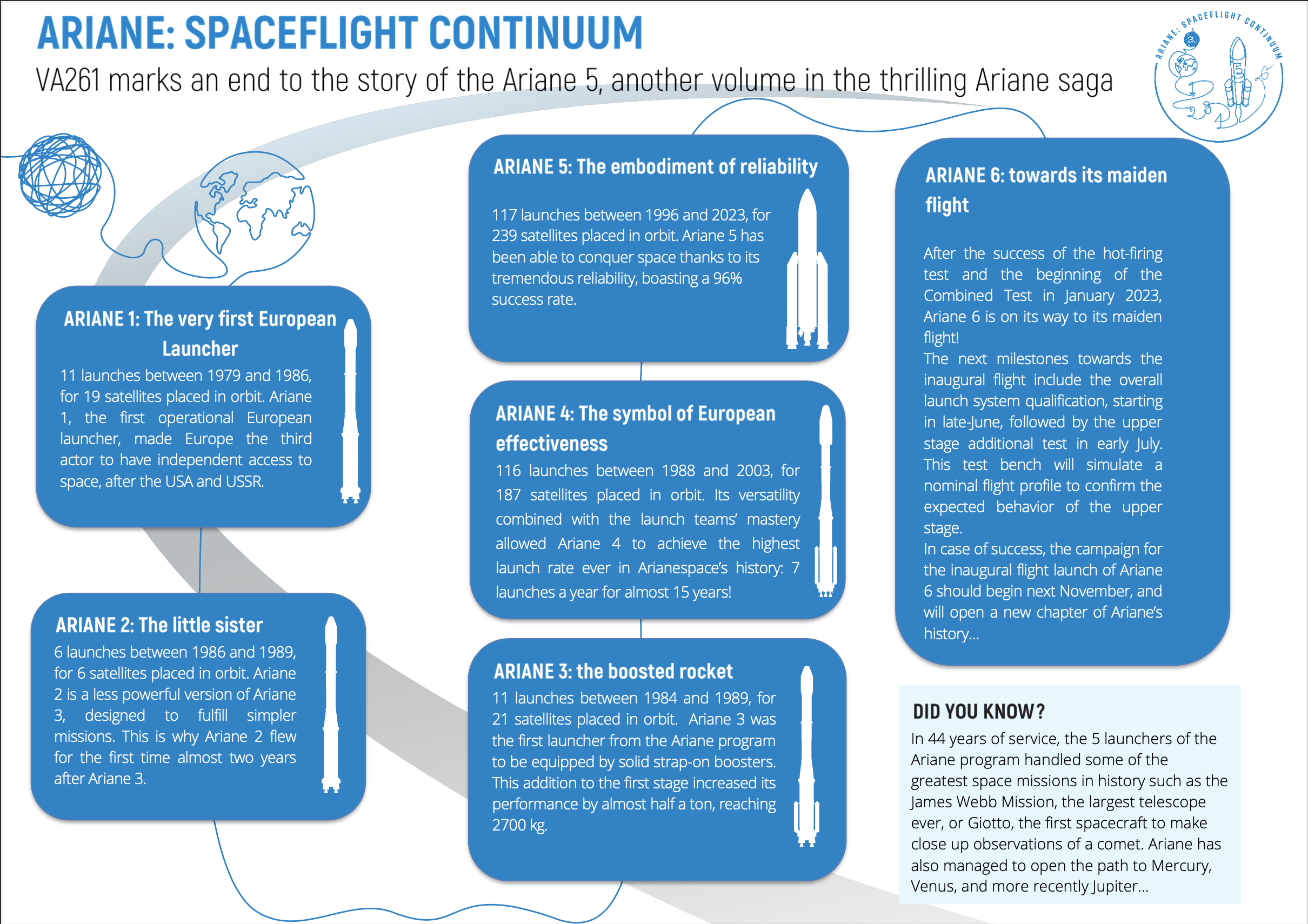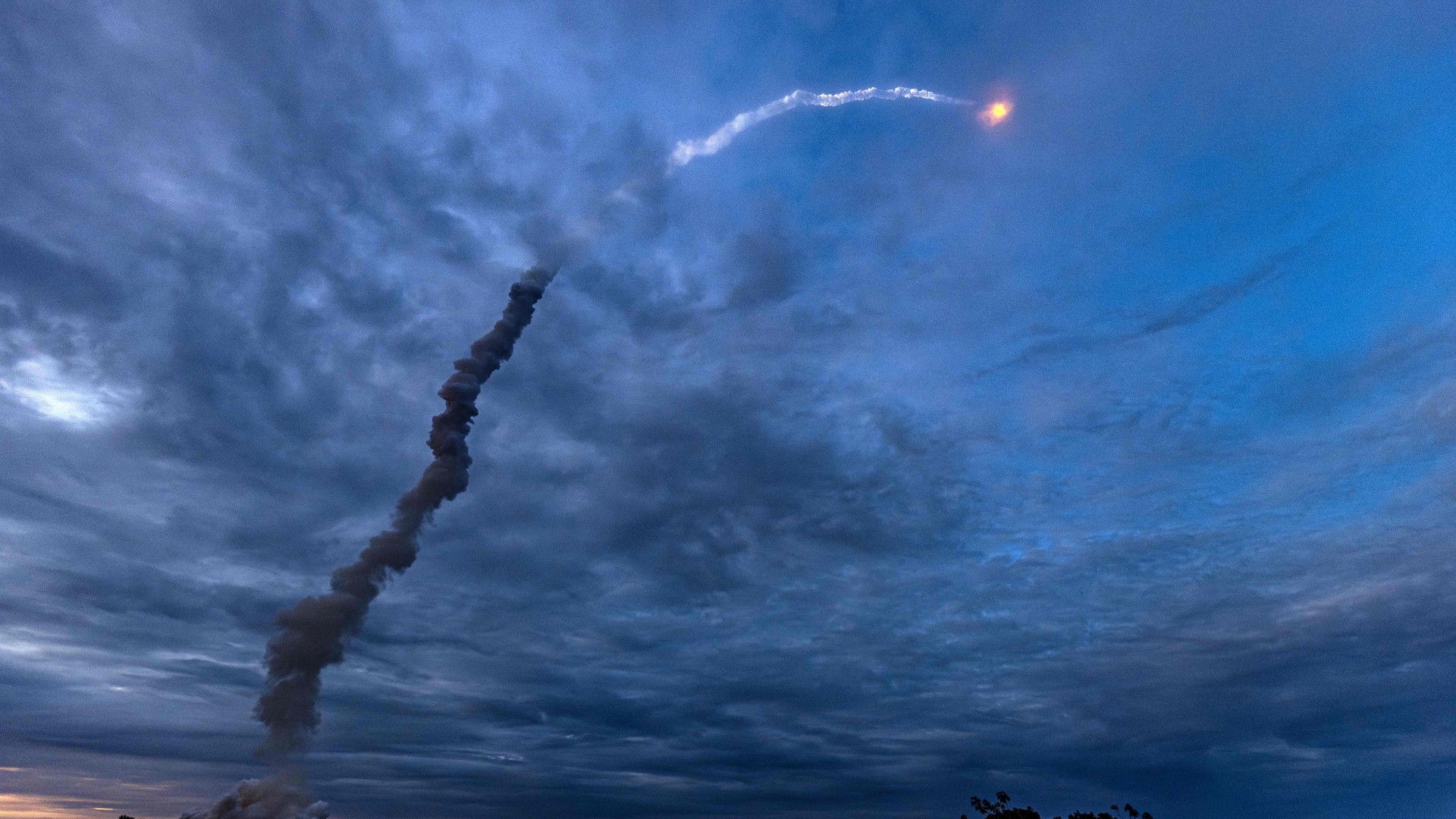Farewell, Ariane 5! Europe's workhorse rocket launches 2 satellites on final mission (video)
After 27 years of service, Europe's venerable heavy lifter has rocketed into retirement.
Europe's workhorse rocket has flown for the final time.
The powerful Ariane 5 launched today (July 5) on the last-ever mission of its storied career, which began way back in 1996 and now includes 117 orbital liftoffs.
Today's mission began at 6 p.m. EDT (2200 GMT), when the Ariane 5 launched from Europe's Spaceport in Kourou, French Guiana. About 2.5 minutes into flight, the vehicle's 103-foot tall (31.6 meters) solid rocket boosters separated from the core stage, whose single engine continued burning, carrying the mission's two satellites skyward.
The core stage shut down around nine minutes after liftoff, and the upper stage separated and began its own burn. Approximately 30 minutes into flight, the first satellite, called Heinrich-Hertz, was released into geostationary transfer orbit high above Earth. About three minutes later, the second payload, known as Syracuse 4B, followed suit.
"Ariane 5 has perfectly finished its work," Stéphane Israël, CEO of Arianespace, the France-based company that operated the rocket, said on today's launch webcast shortly after that second deployment. "It's really now a legendary launcher."
Related: The top 10 Ariane 5 rocket launches of all time
Heinrich-Hertz is an experimental communications satellite that will test new hardware and serve as a test platform for university and public sector scientific and technical experiments.
Breaking space news, the latest updates on rocket launches, skywatching events and more!
Its mission will be managed by the German space agency, known by the acronym DLR. Heinrich-Hertz is the first German satellite dedicated to such technology demonstration and communications research.
Syracuse 4B is joining its predecessor, Syracuse 4A, which launched in 2021. The pair were built for the French government by Airbus Defence and Space, and are replacing the Syracuse satellites 3A and 3B as military communication relays.
Both Heinrich-Hertz and Syracuse 4B are headed for geostationary orbit, which lies about 22,200 miles (35,800 kilometers) above Earth. They'll get there by performing a series of engine burns.
Today's flight ended a nearly 30-year operational career for the Ariane 5, which out-launched the four other Ariane rockets that came before it.
"Ariane 5 leaves behind an incredible legacy of technical prowess and reliability," a spokesperson for the European Space Agency (ESA) told Space.com. "During its operational lifetime, Ariane 5 has been a major asset for Europe to ensure its autonomous access to space."
The two-stage rocket was operated by Arianespace for ESA and CNES, the French space agency, and was built by Airbus Defence and Space. The Ariane 5 has gone through a handful of upgrades and has flown in five different configurations. The most recent versions, the Ariane 5 EC/A and ES, began operation in 2009. The predecessor design, the Ariane G5, launched from 2005 to 2009, after succeeding the short-lived G+ version, which launched three missions in 2004, and the premiere Ariane 5 G prior to that.
Ariane 5 first launched in 1996 but failed to reach orbit on that debut, initiating an auto-destruct abort mid-flight. After that initial failure, the rocket became one of the world's most reliable launchers. Of Ariane 5's 117 missions and 239 payloads delivered to orbit, the launch vehicle has performed at a 96% success rate, according to ESA.
Development of the Ariane 5's replacement, the Ariane 6, has been proceeding for more than a decade. "Ariane 6 is a new launcher system, which will be more flexible, cost-efficient and serve more types of launches compared to Ariane 5," said an ESA representative. Europe’s new rocket will be designed to fly in two configurations, A62 and A64, which carry two and four solid rocket boosters, respectively.
The new heavy lifter was originally expected to debut in 2020, but setbacks have repeatedly pushed that target down the calendar. Ariane 6 is now expected to launch no earlier than late 2023, leaving Europe with a gap of launch options until it's ready.
"Where necessary, alternative launcher options have been investigated and evaluated by ESA from a technical, schedule and security point of view to ensure the continuity of service of European programs," said an ESA official. In April, it was reported that the European Commission was exploring the possibility of launching some of the European Union's Galileo navigation satellites using a SpaceX Falcon Heavy rocket rather than wait for the Ariane 6 to come online.
"ESA and its partners are working relentlessly to secure rapidly and reliably the inaugural flight of Ariane 6, which remains the preferred launch option for European mission requiring a heavy launch vehicle," said an agency spokesperson.
Today's Ariane 5 swan song originally scheduled for June 16 but was scrubbed the day before due to issues with the solid rocket boosters’ pyrotechnical transmission lines. The next planned attempt, on Tuesday (July 4), was nixed by bad weather.

Josh Dinner is the Staff Writer for Spaceflight at Space.com. He is a writer and photographer with a passion for science and space exploration, and has been working the space beat since 2016. Josh has covered the evolution of NASA's commercial spaceflight partnerships and crewed missions from the Space Coast, as well as NASA science missions and more. He also enjoys building 1:144-scale model rockets and human-flown spacecraft. Find some of Josh's launch photography on Instagram and his website, and follow him on X, where he mostly posts in haiku.



